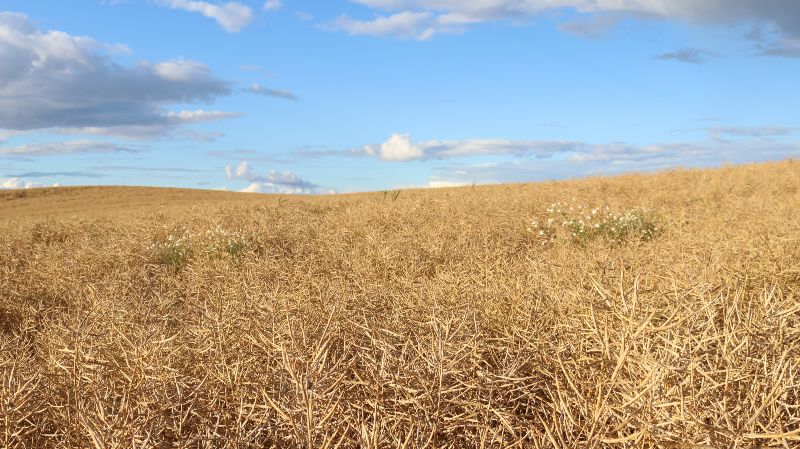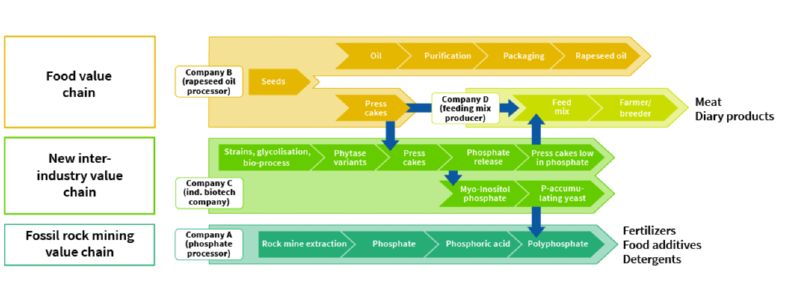
The need to recover essential resources, such as phosphate from side- or waste streams, confronts existing industries with numerous challenges. Bio-based technologies can be the solution here. However, existing obstacles include high conversion costs, lack of quality and industry standards and uncertain legal frameworks. The P-ENG project establishes a method for the recovery of phosphate from rapeseed press cakes and investigates how value chains that allow commercialization of this phosphate might look.
Phosphorous as a fossil resource is finite and is mined only in a few regions in the world, including Morocco. However, the raw material is an irreplaceable resource for living beings and many industries, such as fertilizer in agriculture or as an acidity regulator in food production. The world’s phosphate deposits will last only approximately 300 years. Thus, strategies for sustainable phosphate usage and processes for the recovery of phosphate from unused side streams must be found. One example is the production of cooking oil in oil mills. In addition to the cooking oil, which amounts to about 40% of the production, the by-product oil press cake is also produced. The remaining 60 percent of the total production contains a considerable quantity of plant-bound phosphorous in the form of the storage molecule phytate. In the current value chain, oil press cakes are further processed mainly in feed production.
Yeasts as helpers
This was the starting point for the BioSC project P-ENG. Initially, the recovery of phosphate from oil press cake was established using a phytase. Phytases are enzymes that can release phosphate by separating it from phytate. Using biotechnological methods, the phytase was optimized so that it is heat stable. The phytase was produced using a yeast that can use methanol as a carbon source.
The concentration of phosphate was investigated using yeasts, which can store phosphate as polyphosphate. Polyphosphate-rich yeast extract or pure bio-based polyphosphate can be used as a food additive and thus presents a biological alternative to chemically produced polyphosphate.
Furthermore, this technology offers the chance to produce feed with a lower phosphate content. This is because livestock such as pigs or poultry cannot adequately digest plant-bound phosphate in feed, so that unused phosphate reaches wastewater through the animals’ excretions or onto fields through manure fertilization. The phosphates then pollute rivers and lakes. The recovery of phosphate before further processing to feed would counteract this problem.

New networking of markets
However, market implementation of this technical process is accompanied by challenges and changes in existing value chains. Within the framework of the P-ENG project, experts from classic polyphosphate producers, oil mills, enzyme producers and feed producers were interviewed to investigate these challenges for the existing market.
At the moment, there are no connections between the value chain of the oil mill and the polyphosphate producers. In the case of phosphate recovery from oil press cakes and the subsequent processing into polyphosphate, new value-adding networks must be established. The research teams derived different scenarios, depending on which actor assumes the process of enzymatic phosphorus separation. An important prerequisite for the implementation of the process is the investment in a bioreactor, which none of the actors already owns. Assuming that the classic polyphosphate producer undertakes the phosphate extraction, it would have to face the challenges of the lack of the biotechnological know-how and the geographic fragmentation of the oil sector. Furthermore, specific legal and customer-specific requirements on the polyphosphate must be met depending on the field of application. The new bio-based polyphosphate is associated with uncertainties since its exact characteristics remain to be investigated. The lack of standards for the new bio-based polyphosphate also represents an obstacle that makes market implementation difficult. Depending on which actor assumes phosphorous extraction, a forward (e. g. oil mill) or backward (e.g. phosphate producer) integration is necessary in the value chain. Overall, organizational, regulatory, economic, geographic and product-related challenges were identified for the entire value chain.

Biotechnology as mediator
In contrast, there are the enormous opportunities for companies to contribute to a sustainable phosphate economy. The result of the interviews carried out in the framework of P-ENG with existing market participants was a completely new scenario: the researchers established an additional actor – the so-called collector. Since none of the industry sectors currently active in the market possesses all the necessary competences, the new actor could function as mediator between the previously separate value chains. It should be positioned favorably geographically in order to create a kind of bio-based polyphosphate district, which would help to lower logistics and transport costs and make the entire process more sustainable.
Based on reliable data on efficiency, the technology must reach a higher degree of maturity. This is the only way to change the existing business models of established actors and facilitate market introduction of the new technology. Closer networking between science and industry is essential to realize technology transfer and meet the market requirements.
In follow-up projects at the RWTH Aachen, the DBU project Value-PP and the MWIDE project Business-P, a process has been developed over the last years from the release of phosphate using phytase to the generation of phosphate-accumulating yeast cells up to the production of bio-based polyphosphate. The future will show whether the value chain outlined above is feasible.
Project Coordinator
Prof. Dr. Lars M. Blank
ABBt – Applied Microbiology, RWTH Aachen
Email
Participating Core Groups
Prof. Dr. Lars M. Blank, Jana Fees
ABBt – Applied Microbiology, RWTH Aachen
Prof. Dr. Stefanie Bröring, Dr. Laura Carraresi, Carolin Block
ILR – Technology, Innovation Management and Entrepreneurship, University of Bonn
Prof. Dr. Ulrich Schwaneberg, Dr. Anna Joëlle Ruff
ABBt - Biotechnology, RWTH Aachen
Prof. Dr. Wolfgang Wiechert, Prof. Dr. Marco Oldiges
IBG-1 Biotechnology, Forschungszentrum Jülich
Funding Period
01.01.2015 – 31.12.2016
Funding
P-ENG is part of the NRW-Strategieprojekt BioSC and thus funded by the Ministry of Culture and Science of the German State of North Rhine-Westphalia.